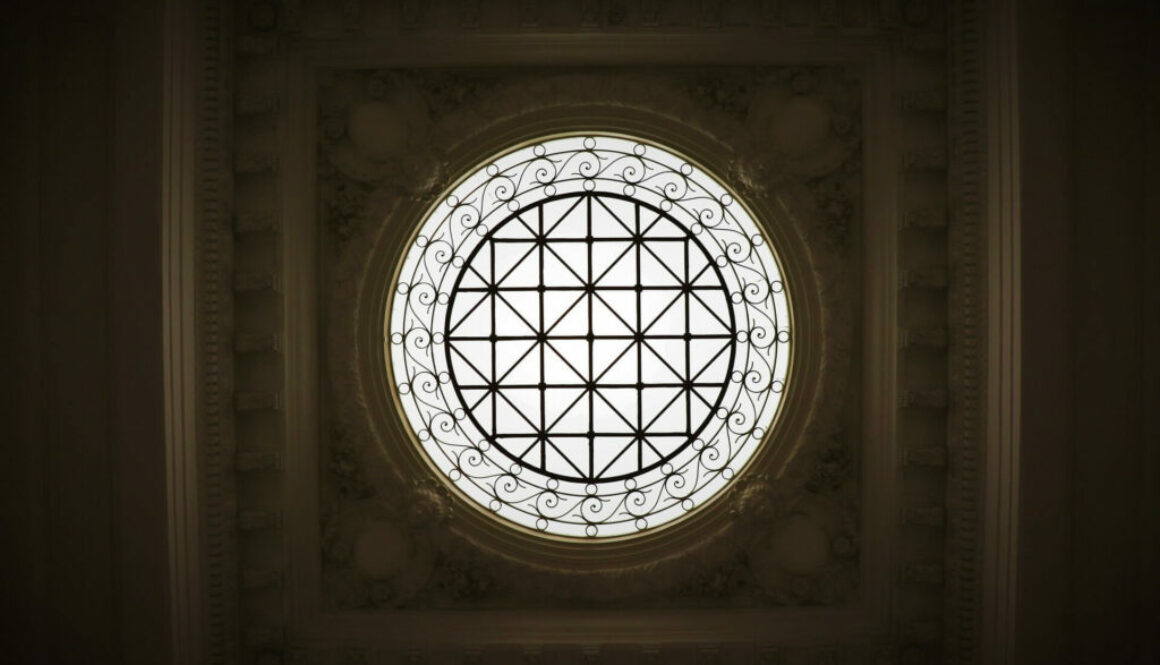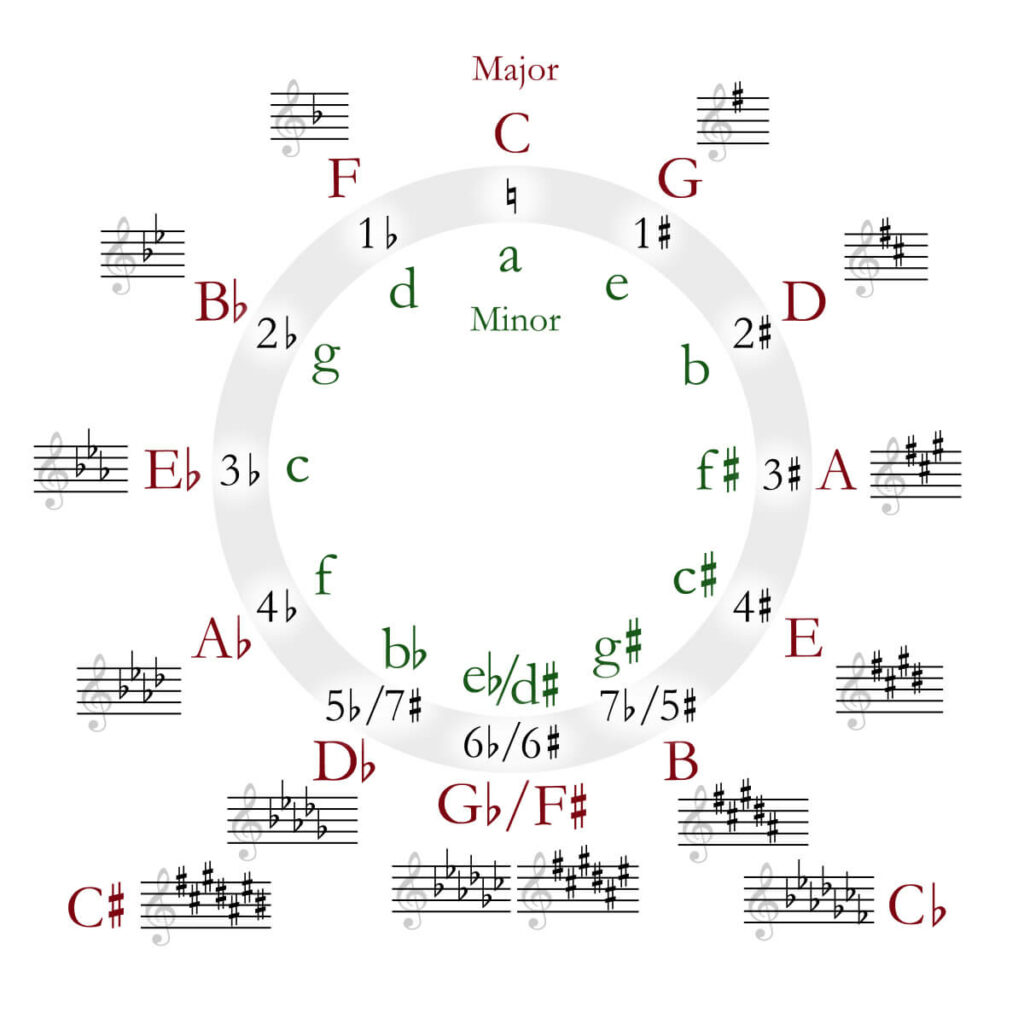The Circle of Fifths and the Guitar

If you are not familiar with the Circle of Fifths, it may seem a little confusing. After all the letters are not in alphabetical order and without any music training the image doesn’t help much. However once you break the code you realize how simple it is! In this article we will show you exactly how to use the Circle of Fifths while playing guitar.
What is the Circle of Fifths?

Even trained musicians keep a copy of the Circle of Fifths, it’s a great reference to refer to for all skill levels. In Western music we have 12 notes that are a semitone apart, a semitone is the space of a piano key or one guitar fret. And every song we write, or play is built with note intervals. If you want to train your ears, the best way to start is by studying the intervals between these twelve notes.
Some intervals are perfect, which means they have a very solid sound and consonance. Other intervals are minor (a sad feeling), major (uplifting), and tritone (dissonant and off). A song is created by the tension and resolution of these different intervals, we use the appropriate interval for each emotion or vibe. The most important and consonant interval is the 5th. In the C major scale, the fifth is a G.
| 1 | 2 | 3 | 4 | 5 | 6 | 7 |
| C | D | E | F | G | A | B |
If you play a C and G separately or together you will see how strong their pair is. Ever since the time of Pythagoras, the fifth has been essential in harmonics. As we build our notes into chords, these intervals still follow the same rules. A C chord and G chord also go together very well. Now look at the Circle of Fifths again, and if you start on C each note going clockwise is a fifth apart! Hence the name! If you keep going you will end up back at C.
The other perfect interval is the fourth, it also sounds consonant, but it’s not as strong as the fifth. In the C major scale the fourth is F, which is counterclockwise to C. So if we go backwards we will move in fourths all the way around the 12 notes back to C again! Moving the opposite way also makes it a Circle of Fourths. If you are using standard tuning on your guitar you will notice the E-A-D-G and B-E are fourth intervals. The guitar is tuned in fourths except for the third interval of G-B! Using a scale finder will provide another way of seeing and deciphering the Circle Of Fifths.
How to Use the Circle of Fifths
The basic point of this graph is for reference and to see which keys we can successfully modulate to. In jazz and pop there are times where you want to change the key of the song and the Circle of Fifths shows us “safe” key movements. In some jazz they use the Circle to constantly keep the music evolving but in a consonant way. And there is more info to find besides the fifths and fourths. The inner circle has the relative minor which is the sixth degree of the scale. Look on the C major scale and you will see the sixth note is A, so A minor is the relative minor of C. We could find this info by looking at a major scale, or quickly referencing our Circle of Fifths.
On the outer circle we have all the key signatures, so C major and A minor both have no sharps or flats. As we move clockwise one new sharp is added until we reach the bottom. If we move counterclockwise one flat is added each time until the bottom again.
Notice the keys on the bottom are enharmonic, as they can be named using flats or sharps. These enharmonic keys are basically the same, but technically different. The composer chooses which version they want to use.
These key signatures are some of the best info as they tell which notes are flat or sharp. So if you forget a major or minor scale, the Circle of Fifths is the fastest way to find it! Besides intervals and scales we can also find chord progressions! One of the most common progressions is the 1-4-5. If we start on C we move counterclockwise to get the fourth and then clockwise to find the fifth, giving us a progression of C-F-G. You can easily copy this movement for any key.
If we want to find the ii, iii, and vi chords we use the inner ring. Obviously the vi is shown which is Am. If we move counterclockwise we get the ii (Dm) and if we move clockwise it is the iii (Em). If someone says the chord progression is I-ii-vi-V we can find that for any key with this chart, for C it would be C-Dm-Am-G. Using a chord finder will help you better understand these terms.
Even More Tips on the Circle of Fifths
There is still more info to be found on this chart, but the movement starts to jump more. If you wish to find the seventh scale degree (vii) you would move straight across from the IV. In C the IV is an F and straight across is the B, which matches with the C major scale above. All this info is repeated and can be checked against the scales if you like.
Another way to find the ii, iii, and vi is by moving ahead on the circle. Notice after G if we go clockwise we see D, A, and E. If you make these minor you have the right scale degrees (ii, iii, vi) for the key of C. Jazz music often uses a ii-V-I progression as it moves around the circle one key at a time. For C we can look at the graph and see the ii-V-I is Dm-G-C. Not every song always modulates to the closest key, but that movement is the most consonant and least jarring.
We can also use triangle shapes to find what notes make up chords! A major chord is made up of the 1st, 3rd, and 5th degree so a C major is C-E-G. Connect these notes with a triangle and anywhere you move that triangle will show you the major chord. Push the triangle back one and we have the notes F, A, and C which makes an F major.
Essentially the Circle of Fifths has multiple ways to find intervals, key signatures, and chords that share harmonic principles. A small movement is musically related, while a big jump is more dissonant. These redundant features can be confusing for some, until they realize there are multiple paths to the right answer. The best way to practice the Circle of Fifths is to print it and keep it attached beside your practice space while taking online guitar lessons. The more you use it, the more these harmonic principles will be understood. This simple graph will give you a head start on music theory and how it applies to instruments like the guitar.
Shawn Leonhardt is a writer for Guitar Tricks and 30 Day Singer.
